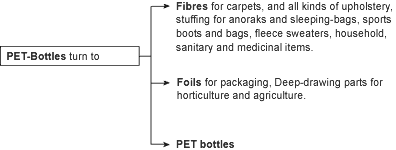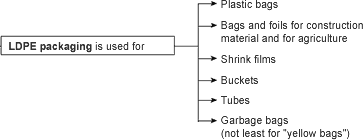Guide
What’s separating good for if everything is then incinerated anyway?
About half of the collected plastic packaging is materially re-utilised, i.e. processed into re-granules from which new products can then again be made. Only the mixed plastic fraction containing heavily soiled and rather small-part packaging parts is mostly destined for thermal dressing. Yet, “thermal dressing” does not mean that the material is eventually dumped in a garbage incineration plant. The plastic parts are disintegrated and used in Austria as alternative fuel instead of coal or oil in the cement industry and the RVL Lenzing for energy generation. In both utilisation processes, natural resources are saved.
What should be put in the "yellow container" or "yellow bag"?
Yellow containers and yellow bags are only for plastic packaging and nothing else!
What to put in:
- All types of plastic film
- Plastic bottles (e.g. for drinks, washing-up liquid, cleaning products)
- Plastic tubes (e.g. for toothpaste)
- Plastic lids and caps
- Yoghurt pots and cups
- Plastic bags
- Margarine tubs
- Canisters
- Plastic mesh (e.g. for onions, lemons)
- Cellophane packaging
- Frozen food packaging (plastic-coated containers)
- Blister packaging (e.g. for medicines)
- Fruit trays
- Meat trays (foamed packaging)
- Styrofoam packaging (packing chips)
- Moulded plastic packaging (e.g. inside chocolate boxes)
- Foamed rubber packaging
- Milk and drinks cartons, if there is no suitable collection system with an Öko-Box
What not to put in:
- All non-plastics
- Nappies
- Construction plastics (e.g. pipes)
- Plastic clothing (e.g. boots)
- Plastic bowls, baskets and other kitchen utensils
- Electronic items (e.g. power cables, sockets)
- Children’s toys
- Medical items (e.g. infusion equipment)
- Small plastic parts (e.g. plastic sleeves from the office)
Is it necessary to clean collected plastics before disposing them in the "yellow container" or the "yellow bag"?
What is granulate/regranulate?
What are recyclates?
In most cases our recyclates can be used to manufacture products the same as or similar to the original products prior to disposal, completing the recycling loop.
Types of plastics

![]() HDPE (high-density polyethylene) is harder and stiffer than LDPE (low-density polyethylene). Withstanding higher temperatures and highly resistant against chemicals, it is used for all kinds of bottles (shampoo, detergents, etc.) as well as for cans, buckets and beverage boxes.
HDPE (high-density polyethylene) is harder and stiffer than LDPE (low-density polyethylene). Withstanding higher temperatures and highly resistant against chemicals, it is used for all kinds of bottles (shampoo, detergents, etc.) as well as for cans, buckets and beverage boxes.

![]() LDPE (low-density polyethylene) is the most used plastic material for packaging, e.g. for all kinds of foils and plastic bags. LDPE is extremely resistant against chemicals, almost tight against water vapour and is odourless and taste-neutral.
LDPE (low-density polyethylene) is the most used plastic material for packaging, e.g. for all kinds of foils and plastic bags. LDPE is extremely resistant against chemicals, almost tight against water vapour and is odourless and taste-neutral.

![]() PP (Polypropylene) is oil and grease resistant. It has a very low permeability for water and oxygen. Consequently, it lends itself for packaging margarine, edible oils, mayonnaise, ketch-up, mustard, salad dressings, savoury biscuits, bread, cakes and pastries. In most cases, screw caps of PET and HDPE bottles are made of polypropylene.
PP (Polypropylene) is oil and grease resistant. It has a very low permeability for water and oxygen. Consequently, it lends itself for packaging margarine, edible oils, mayonnaise, ketch-up, mustard, salad dressings, savoury biscuits, bread, cakes and pastries. In most cases, screw caps of PET and HDPE bottles are made of polypropylene.

![]() PS (polystrene) is used above all for yoghurt and cream pots.
PS (polystrene) is used above all for yoghurt and cream pots.

![]() EPS (expanded polystrene) is known under the trade name “Styropor”. Used as packaging material it protects fragile products and devices susceptible to shocks.
EPS (expanded polystrene) is known under the trade name “Styropor”. Used as packaging material it protects fragile products and devices susceptible to shocks.
